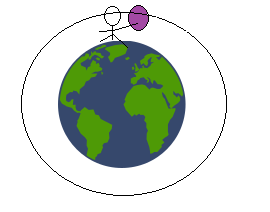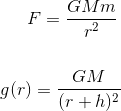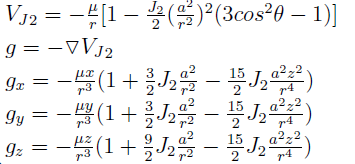Orbit Propagator
Contents
Introduction
Propagator is a model whose objective is to determine the position of satellite at any instance of time, with given acceleration and initial velocity. If we assume the earth is spherical and only earth’s gravitational field is affecting satellite motion then the problem would be pretty easy to solve but the issue arises when other factors like earth oblateness, gravitational force from moon and sun, atmospheric drag and solar pressure come into play.
There are some factors which affect the propagation more than others. For example, a satellite which is orbiting around earth will be greatly affected by earth’s oblateness rather than gravitational field of sun and moon (as they are very far away). As the number of the factor taken into account in the model increase, the complexity of the model increases.
To get more accurate model, one needs to account for many factors but they come at the cost of computational time and power. A satellite completely depending on the model will demand more accuracy than a satellite using the model, but correcting it's position from time to time using a GPS. There are following models available as per the application and accuracy, some of them are listed here. [1]
- Two Body Propagator
- J2 propagator
- J4 propagator
- Simplified General Perturbation (SGP) Model
- Simplified Deep Space Perturbation (SDP) Model
In this article, which is mainly focuses on LEO satellites, only Two body propagator, J2 Propagator and SGP models are covered. Simplified Deep Space Perturbations (SDP) models is not applied for LEO satellites, it is for higher altitude satellites. It is more complex and not beneficial for student satellite projects.
Two Body Propagator

Assume there are only two bodies in space, one is earth and other is your satellite and only gravitational force acting between these two.
As you might have heard or read that if you throw a ball horizontally from a certain height with the correct velocity then it will revolve around earth. Well this is the same thing. Once you know from where and when you throw the ball, you will get the position of the ball at any instant of time, with these equation of g by integrating it twice with respect to time. This is a very crude model and it doesn’t even generate a sun-synchronous orbit.
J2 Propagator
The fact that earth rotates around its own axis makes it fat around the equator due to centrifugal force acting on it. So it becomes like orange not like a football. The earth’s equatorial radius is 21 km larger than the polar radius. This flattening at the poles is called oblateness (oblateness = [equatorial radius − polar radius]/equatorial radius). [2]
The beauty of oblateness of earth allows a satellite to form sun-synchronous orbit.Most of the earth observation satellites are in this orbit because the illumination angle will be nearly the same every time that the satellite is overhead.
The satellite, when it is near to the equator will experience more force than when it is near the poles. The force will be constant for any value of longitude as the variation is only in latitude. One can write the gravitational potential for this and by partially differentiating it with respect to the interested co-ordinate one can get the acceleration. Once you get the acceleration, you can get the velocity by integrating once and the position by integrating again.
Here the gravitational potential is written which accounts for J2. [3]
Simplified General Perturbation (SGP) model
J2 propagator is nice, it forms sun-synchronous orbit, it is based upon numerical integration approach but it doesn’t account for many other factors which means it is not very accurate. SGP model has been developed by NORAD and NASA and uses Two line element (TLE) data and gives the position and velocity of satellite in ECI frame at given instant of time. This model is a collection of polynomial equations (no numerical integration involved) which accounts for J2 and J4 perturbations, atmospheric drag and other secular effects.[4][5]
This model is are very popular and the code, that initially had been written in Fortran, has been translated into MATLAB, python and other languages.
Two line element is a collection of orbital parameters such as eccentricity, argument of perigee, inclination etc. and coefficient of atmospheric drag etc. TLE data is defined as the initial point of propagator after which the position and velocity is calculated. [6]
J2 propagator and SGP propagator are very powerful and useful for orbit propagation however they drift by more than 3km a day. So over a long period of time, the drift would become problematically large. To correct this error, we use GPS from time to time. One may ask why not use GPS all the time for position determination. The answer lies in power consumption. In space we have limited power but more responsibility.
Comparison between J2 and SGP
| J2 | SGP |
| Accounts for only earth’s oblateness. | Accounts for earth’s oblateness, atmospheric drag and other secular effects. |
| Simpler model | Little complex model but it is available. One need not to make one. |
| Numerical Integration involved | Polynomial terms |
| No requirement of data in TLE form | TLE data required |
If you are done reading this page, you can go back to Attitude Determination and Control Subsystem
References
- ↑ http://help.agi.com/stk/index.htm#stk/vehSat_orbitProp_choose.htm
- ↑ Orbital Mechanics for Engineering Students, Section 4.7, page 177-181
- ↑ Spacecraft dynamics and control : an introduction / Anton H.J. de Ruiter, Christopher Damaren, James R. Forbes
- ↑ The effect which is constantly increasing (or decreasing) over time. It’s magnitude might be small but over time it’s value would become large.
- ↑ https://www.celestrak.com/NORAD/documentation/spacetrk.pdf
- ↑ http://www.stltracker.com/resources/tle

